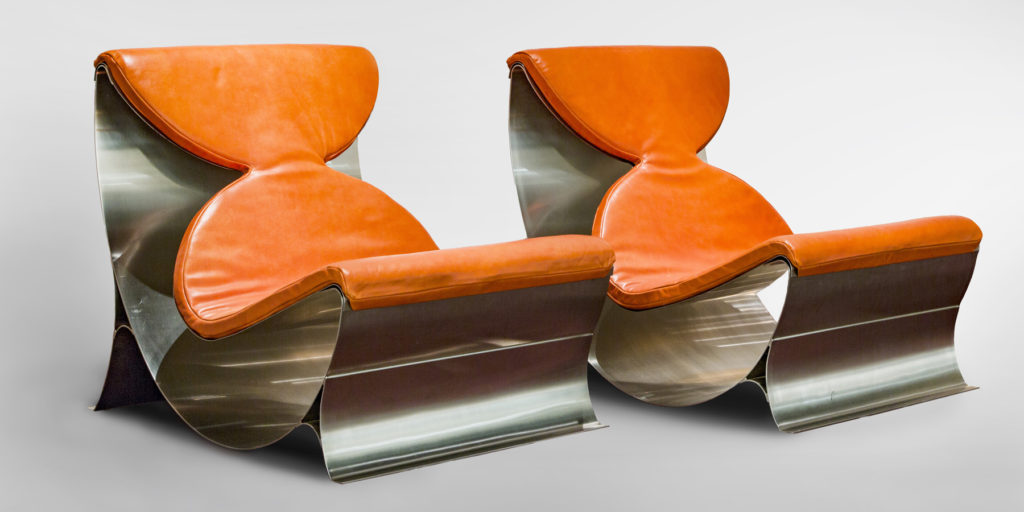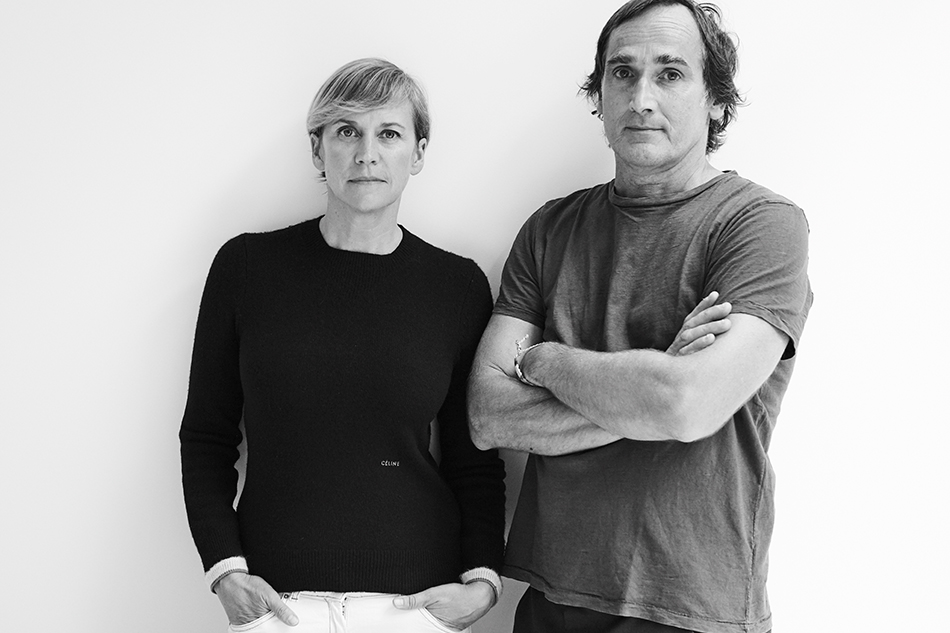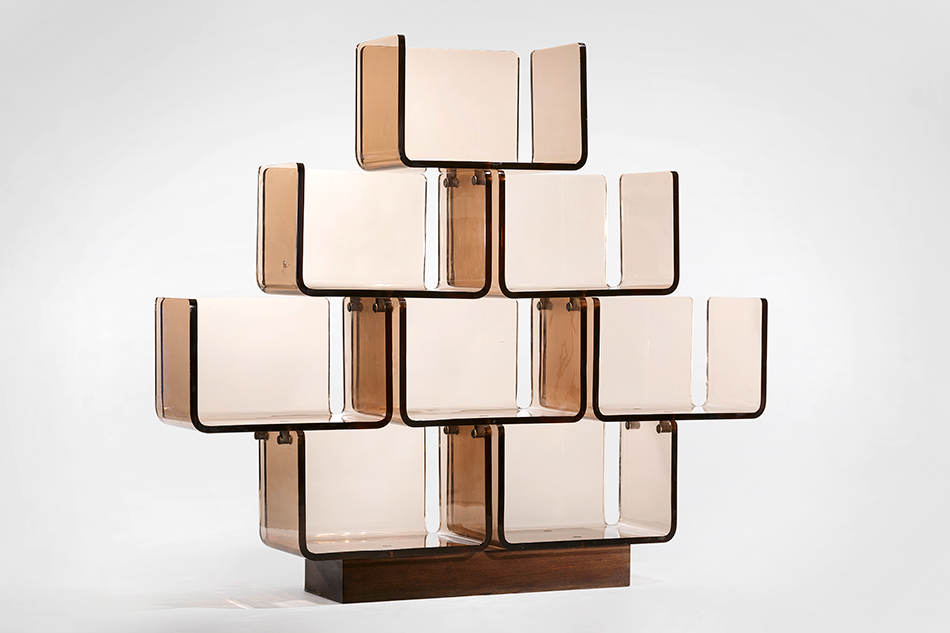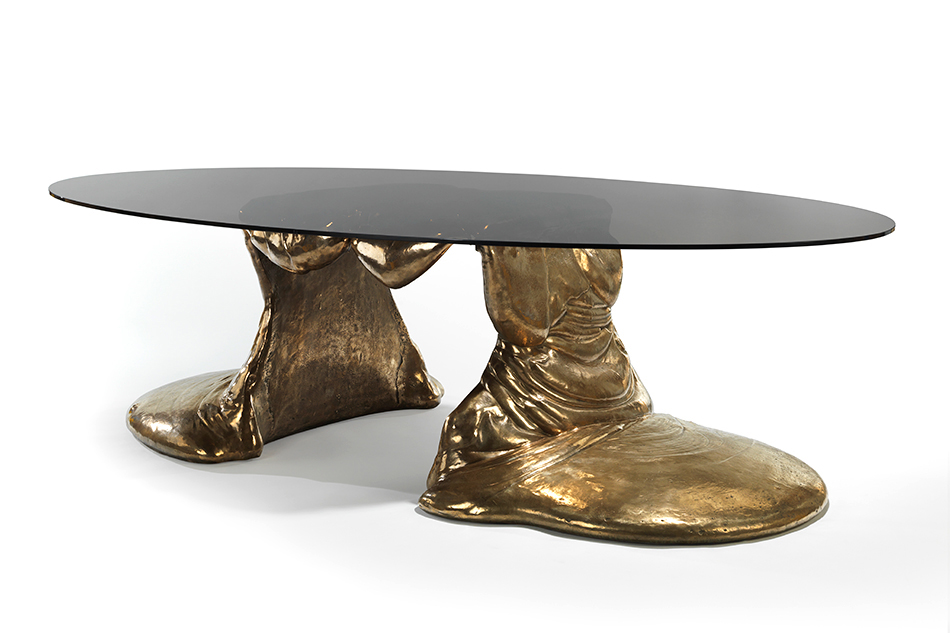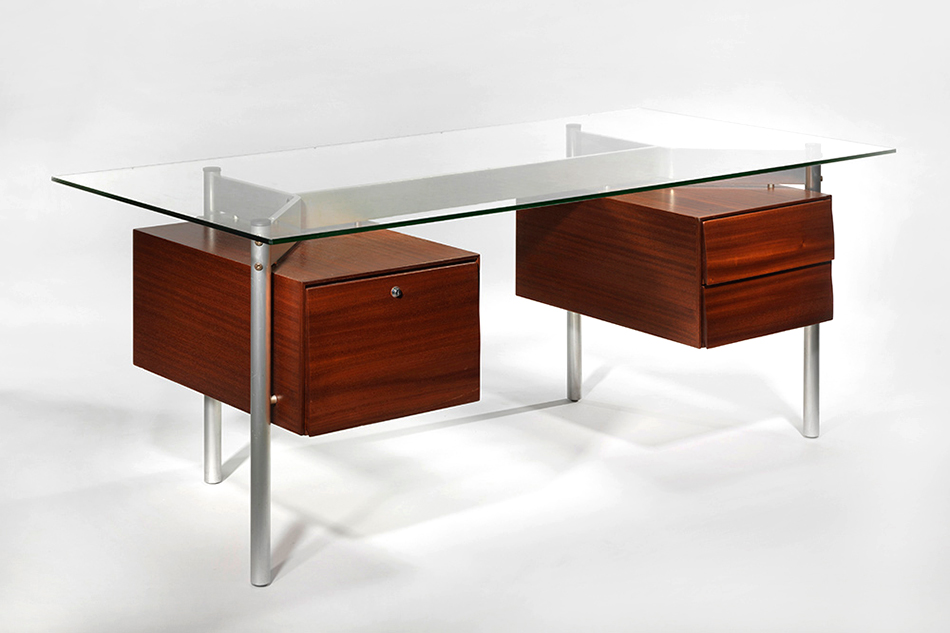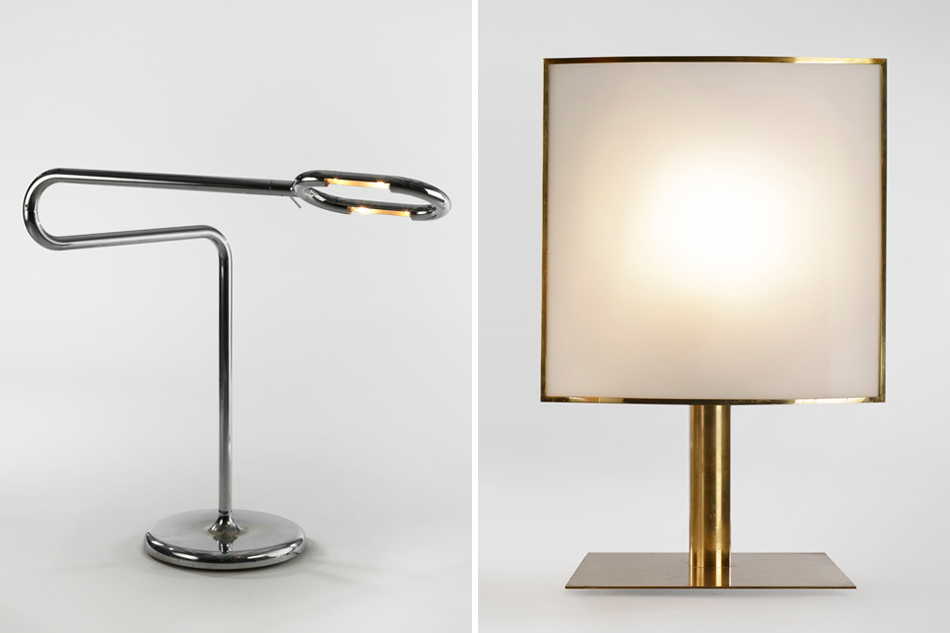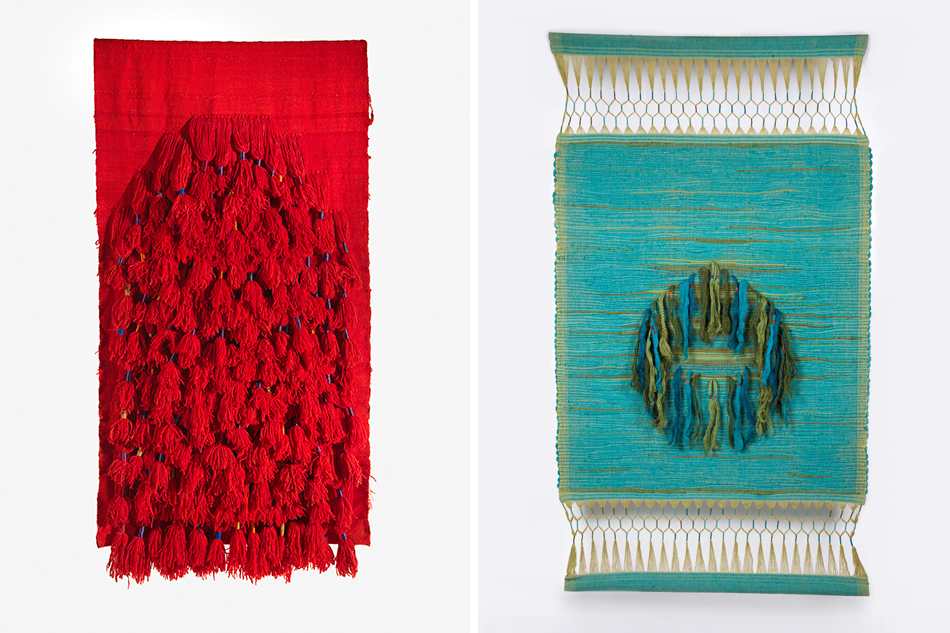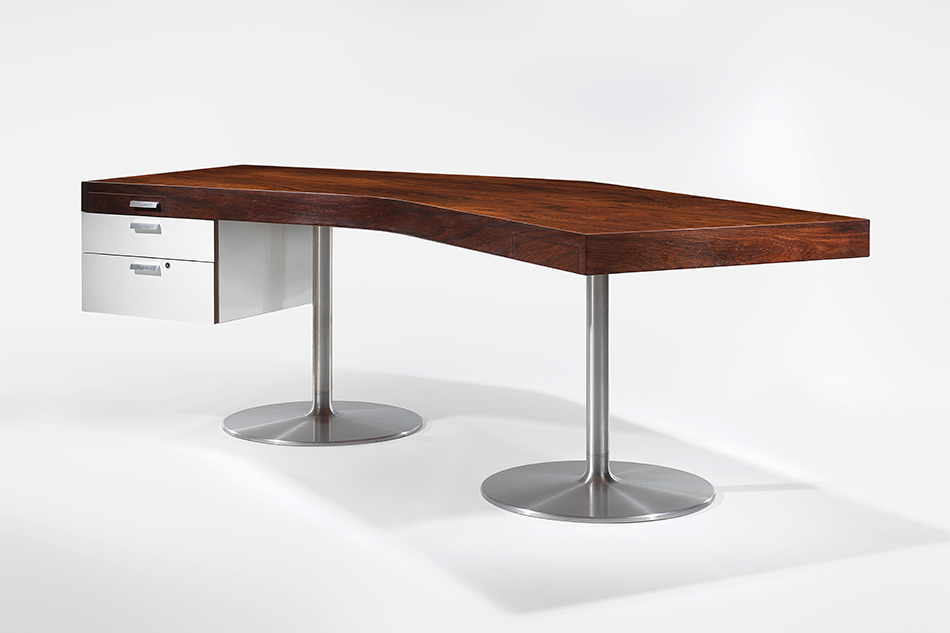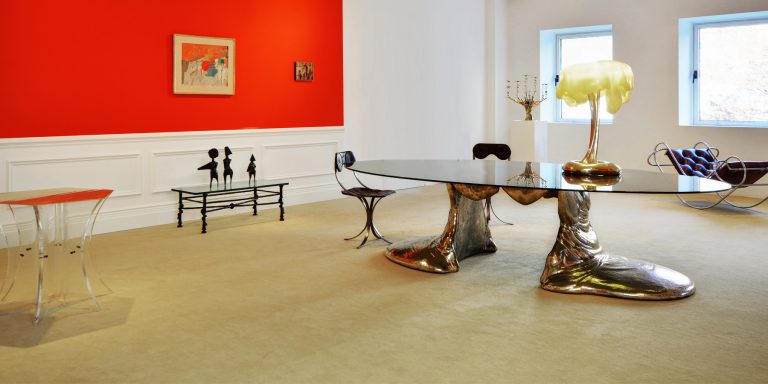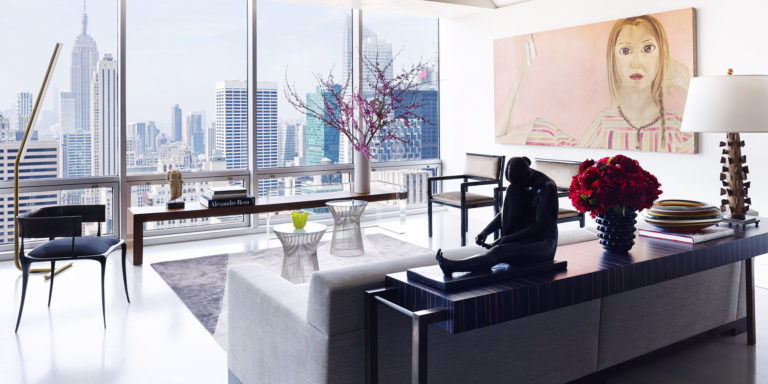
September 26, 2016A Sheila Hicks Palghat tapestry, ca. 1966, hangs above a Maria Pergay Pouf Vague (Wave Bench), 1970, in the Demisch Danant showroom. Top: This pair of stainless-steel lounge chairs were designed by Maria Pergay in 1970. All photos by Pablo Enriquez
Our business is about telling stories,” says the dealer Stephane Danant, “about the designer, about the period, about the places, about the rooms. It’s inspiring for us, and it’s inspiring for others. Otherwise, you are just providing material.”
Since Danant and his partner, Suzanne Demisch, opened Demisch Danant in New York’s Chelsea gallery district in 2005, they have dedicated themselves to telling the story of postwar French design from the 1950s to the ’70s, when André Malraux was the country’s cultural minister and there was a general climate of support that led to many public commissions.
Demisch and Danant have made the case for the significance of this period by carrying out careful scholarship, producing the occasional monograph and mounting a regular volley of elegantly curated shows and art fair booths. They led the way in rediscovering the work of designers like Joseph-André Motte, who designed seating for Paris Metro stations as well as for the city’s Orly and Charles de Gaulle airports. They also reintroduced the lesser-known work of Pierre Paulin, particularly that produced for the Élysée Palace, where he designed rooms for two presidents — including the futuristic igloo-shaped smoking chamber he created for the private apartment of Georges Pompidou and the neoclassical offices of François Mitterrand, which he enhanced with groovy blue-lacquered postmodern desks and chairs. In addition, they tracked down Maria Pergay, whose sensuous stainless-steel chairs and chaises had once been favored by Pierre Cardin, and persuaded her to begin producing new work.

The Verre Lumière studio pieces in the exhibition include Ben Swildens’s Egg lamp, 1969; Pierre Soulié’s table lamp, 1970; and Michel Boyer’s Screen lamp, 1975.
Now, Demisch Danant has reopened in a much larger storefront at 30 West 12th Street that for decades was an Italian bookstore and has been redesigned as a gallery by Rafael de Cárdenas, founder and principal of the New York firm Architecture at Large. Demisch Danant’s first exhibition in the new space, “Made in France” (through October 29), includes work by Motte, Paulin, Pergay and Michel Boyer, as well as furniture and art by the sculptor César and historical pieces by the textile designer Sheila Hicks. Fresh finds are also on view, from the Parisian designer Étienne Fermigier and the Verre Lumière studio, which produced lighting for designers and architects like Paulin and Boyer between 1968 and ’89.
“The show is a personal narrative about what we’re interested in and why, and how we came across the work,” says Demisch. “We wanted to show our new discoveries and to include the audience in our process.”
The duo’s own story began in 1999, when Demisch, then a New York–based private dealer, happened upon Danant’s booth at the Paul Bert Serpette antiquarian flea market in Paris and bought a table by Roger Capron. From the start, “we got along well,” Danant recalls. “We started talking about our interest in nineteen-seventies furniture.” He soon visited Demisch in New York, and before long, a partnership was born.
They still work together very much as they have done from the start, with Demisch in New York, handling clients, sales and the gallery’s design advisory services, and Danant in Paris, overseeing production and restoration. Danant also deals with sourcing and documentation, a process that can be lengthy. “Most of the information about this period comes from design magazines of the time,” he says, “because there are no books. You see images of pieces by people you don’t know and you start off selecting one and two. Then you start collecting them.”

In an exhibition in Demisch Danant’s new Rafael de Cárdenas–designed Manhattan gallery, Pierre Paulin‘s Cathedral table, 1981, is paired with Joseph-André Motte’s Quevily armchairs, 1967.
It took Danant years to piece together the story of — and gather works by — Fermigier, of whom little is known because he died in a car accident in 1973, at age 41.Although some designers aren’t as intriguing as they initially seem, Danant says, Fermigier’s work turned out to be as rich and radical as he could have hoped. After years of research, during which Danant slowly built a collection of the minimalist designer’s work – “if I find two or three pieces a year it’s really good,” he says –he located Fermigier’s archives. They are maintained by his widow, who, once the two had established a relationship, granted Danant access, and he is now working on a monograph.
Tracking down the tale of Verre Lumière, whose lamps the gallery has offered for some years, is proving to be a similarly painstaking process. “We’ve carried some of their lamps for a very long time, but I always knew it was a wider story than we realized,” Danant says. He recently discovered that the firm also took on public lighting commissions and is trying to figure out which designers were involved. “You think you are on a small path, and then it becomes wider,” he says, “and all of a sudden it becomes, ‘Wow!’ ”
“It starts with one find, and then the connections fall into place,” says Demisch. “The discovery process is part of connoisseurship.” When it comes to communicating that connoisseurship to the public through exhibitions, “that’s something we decide together,” Danant says. “What’s the vibe, what’s the mood, what do we want to show.”
Rodman Primack, the director of Design Miami, who has seen and admired every booth Demisch Danant has presented at the fair, credits the pair with having “a stylish but very restrained” presentation style. (The gallery was a founding member of Design Miami, and Demisch now sits on the selection committee.) Although many dealers regard fairs as a “primary selling moment,” Primack says, “Suzanne and Stephane are always looking at the long game. They’re willing to take risks, to bring work to the fair that doesn’t have a really big market and to use that moment to educate people.”
“It’s a tough job to present real design,” Danant says, only half joking. So far, the duo’s strategy of combining an eye for refined chic with a nose for a good design story has won them plenty of admirers.
